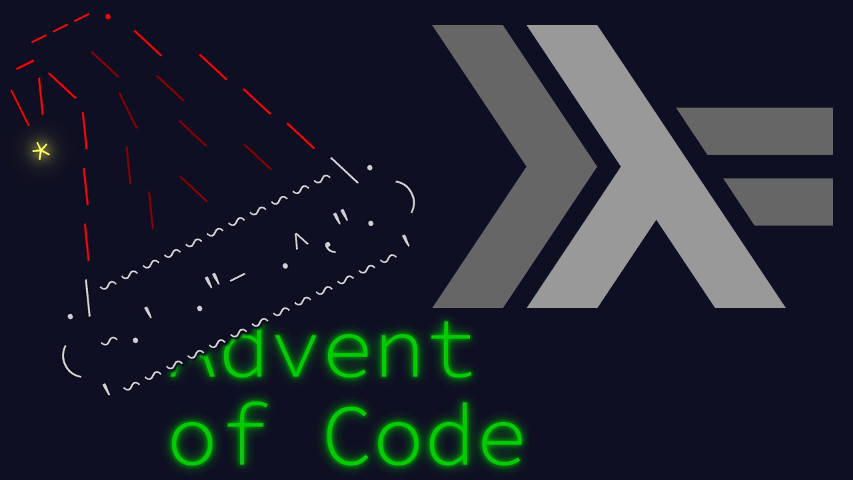More movement on a 2D grid! What a surprise! In today’s Advent of Code puzzle, “Reindeer Maze”, we’re playing shortest paths. Still literate Haskell, still a bunch of imports to get the thing started.
import Control.Arrow ((&&&))
import Data.Array (Array,listArray,assocs,(!))
import Data.List (find,foldl')
import Data.Maybe (maybeToList)
import Data.Semigroup (Min(Min))
import Linear.V2 (V2(V2),perp)
import Data.Map.Strict (Map)
import Data.Set (Set)
import qualified Data.Map.Strict as Map
import qualified Data.Set as SetOk, a 2D grid again. Here’s two type synonyms and a
parse function you’ve read quite a few times already.1
type V = V2 Int
type Grid = Array V Char
parse :: String -> Grid
parse s = listArray (V2 1 1,V2 h w) (concat raw)
where raw = lines s
h = length raw
w = length (head raw)So, shortest paths. This time, actually with different costs per move, so our good old BFS won’t cut it anymore, we’ll need full Dijkstra. Our state will simply be position and orientation. In our search nodes, we’ll want to remember cost, I mean, score—the one we want to lower—, the current state, and the state we reached this through. Score first, as it’s the major Dijkstra order.
data State = State { statePos :: !V, stateDir :: !V } deriving (Eq,Ord)
data Node = Node
{ nodeScore :: !Int
, nodeState :: !State
, nodePred :: !(Maybe State)
}
deriving (Eq,Ord)Node expansion goes 3-way: 2 turns and 1 step forward.
expand :: Node -> [Node]
expand Node{nodeState=nodeState@State{..},..} =
[ Node (nodeScore+1000) nodeState { stateDir = perp stateDir } prev
, Node (nodeScore+1000) nodeState { stateDir = -perp stateDir } prev
, Node (nodeScore+ 1) nodeState { statePos = statePos + stateDir } prev
]
where prev = Just nodeStateI can never get an intuition for which direction perp
points to in an indirect system. Lucky me, it doesn’t matter, both turns
are treated equally.
Now here comes the puzzle’s complications.
Complication one: the goal state is not known. I mean, we know the goal position. But the position is only one part of the state; the other being orientation. And all goal-positioned orientations aren’t necessarily The One. It usually doesn’t matter,2 but in today’s problem we’re going to be backtracking down the states, and the end state we’re tracking back from isn’t that obvious from a direction perspective.
Complication two: we’re (spoiler alert: for part 2) interested in all shortest paths. So we’ll need to keep track of them all. This makes Dijkstra bookkeeping more “interesting”. For backtracking purposes, we want to record which nodes we reached another node from in its predecessor list—if it’s reached at least simultaneously, obviously—, but we don’t really want to expand that node again: any successor is indistinguishable from the ones we already added to the queue last time we encountered it.
So the simplicity/correctness compromise I choose is the following:
- encountering a state for the first time obviously makes it A best path candidate.
- encountering a state for a non-first time with a strictly higher score obviously makes it a skippable dud.
- encountering a state for a non-first time with a score equal to the current (and final) best one results in an updated closed set including the new node predecessors, and “natural” inclusion in the queue of the same successors as the previous time around. Rationale: they’re not that many to begin with, and they’ll be dismissed as soon as they’re detected.
- we’ll explicitly keep track of which goal-positioned states are actually final.
So here’s the code to determine whether a node should be explored, returning the new closed set if relevant:
mbVisit :: Archive -> Node -> Maybe Archive
mbVisit cl Node{..} = case Map.lookup nodeState cl of
Nothing -> Just (Map.insert nodeState (nodeScore,maybeToList nodePred) cl)
Just (score,preds)
| nodeScore > score -> Nothing
| nodeScore == score -> Just $
Map.insert nodeState (nodeScore,maybe id (:) nodePred preds) clThis makes use of our expected Dijkstra closed set.
type Archive = Map State (Int,[State])We’re now up to implementing Dijkstra proper. The outer interface is simple. As input we have the grid. As return values, we want:
- the set of states that actually turn out to be goals
- backtracking info per state: score and predecessors
dijkstra :: Grid -> (Set State,Archive)As always, we initialize recursion on the starting position and with
a singleton queue. Not so much as always, we also keep track of which
set of nodes were actually goal nodes (the Set.empty).
dijkstra g = go Set.empty Map.empty q0 where
Just start = fst <$> find ((== 'S') . snd) (assocs g)
q0 = Set.singleton (Node 0 (State start (V2 0 1)) Nothing)Par for Dijkstra, the main iteration step looks for the smallest score available node.
go goal cl q = case Set.minView q ofNone means the queue is empty, exploration is complete. We just need to convert our search-internal data to something the caller actually wants. Namely, goal states,3 and… the entire actual closed set, whose nodes hold the backtracking information.
Nothing -> (Set.map nodeState goal,cl)If we’re not done, split current node from remaining queue.
Just (node,q')We’ve been through a lot of trouble identifying which cases were meaningful. Invoke those now. If the closed set updates, the current node is deemed interesting and explore-worthy.
| Just cl' <- mbVisit cl node -> let
pos = statePos (nodeState node)So let’s explore it.
As discussed above, whether or not it counts as a goal isn’t as
obvious as it looks. Being located in the end 'E' cell is
the obvious part, but since we’re exploring the entire maze and not
stopping iteration when a shortest path is found,4 we
also want to check the current score is actually on par with the best
found so far.
goal'
| g!pos == 'E' &&
not (any ((< nodeScore node) . nodeScore) goal)
= Set.insert node goal
| otherwise = goalFor simplicity, our node expansion function doesn’t check for walls, so we do that here where we have natural access to the grid array, extending the current queue with current node expansions who don’t walk into a wall.
q'' = foldl' (flip Set.insert) q' $
filter ((/= '#') . (g!) . statePos . nodeState) $
expand nodeAnd we can recurse.
in go goal' cl' q''If we’re in such a case that’s not so meaningful, namely, reaching a state with a higher score than previously, no biggie, just skip it.
| otherwise -> go goal cl q'The hardest part is done.
In part 1, we want the score of a best path. Just take the smallest score of any goal.
part1 :: (Set State,Archive) -> Min Int
part1 (goal,m) = foldMap Min . fmap fst $ Map.restrictKeys m goalBy construction, there shouldn’t be any difference between any of them, but I don’t want to bother telling them apart.
In part 2, we’re interested in the set of positions on a shortest path. We’ll get the relevant states by DFS and collapse down to positions.
part2 :: (Set State,Archive) -> Int
part2 (goal,m) = go Set.empty (Set.elems goal) where
go cl [] = Set.size (Set.map statePos cl)
go cl (s:q) | Set.member s cl = go cl q
| otherwise = let cl' = Set.insert s cl
q' = snd (m Map.! s)
in go cl' (q' ++ q)A trivial main function wraps it all.
main :: IO ()
main = interact $ show . (part1 &&& part2) . dijkstra . parseThis concludes today’s solution. See you tomorrow!
I didn’t copy-paste a single one, would you believe it? My fingers just know the way.↩︎
This is all the more painful to write down that it really doesn’t matter as far as my puzzle input goes. So probably yours too. In multiple temporary states of my rewriting of the code, checks for proper goal orientation may have been missing; and yet they returned the very same site-blessed result that’s worth a second star. Meh. If I can’t justify it, I owe myself the proper code, even if the input data isn’t up to speed.↩︎
We don’t need full nodes.↩︎
Since we’re potentially looking for all of them.↩︎



